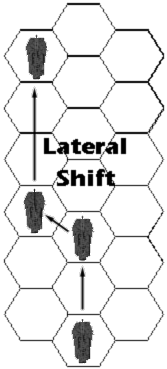
| Variant Familiarity Bonus in Centurion | BACK |
Apply the familiarity bonus as described in Interceptor to individual units in Centurion as well.
2.2 FAMILIARITY(Editor: Of course, adjust the combat mission definition to match Centurion.)
When crews manage to survive battle in the same ship again and again, they gradually learn its subtleties and idiosyncrasies. Because of this familiarity, they receive a bonus to their skill levels when flying that particular ship, as shown on the table below.For familiarity purposes, a combat mission is defined as one in which the crewman has both fired at and been fired at within effective range by an enemy ship or orbital installation, or one in which he shot down at least one enemy ship (armed or unarmed). Ground attack missions do not qualify. The Familiarity Bonus does not apply when a different ship is flown, even if it is of the same type, and it is lost permanently when the original ship is destroyed. Piloting familiarity bonuses are not possible for gunners.
FAMILIARITY BONUS TABLE Combat Missions Piloting Increase Gunnery Increase 1 - 5 +0 +0 6 - 10 +1 +0 11 - 20 +2 +1 21 - 30 +3 +2 31+ +4 +3
| Variant Initiative/Turn Sequence Rules | BACK |
Before play, all units must be assigned into platoons. Infantry carried by vehicles are considered part of that platoon until they dismount, at which point they form a separate element. The Centurion turn is now divided as follows:
Initiative Phase
Action Phase
End Phase
For initiative, each side rolls 1d10. The Centurion's Leadership Rating plays a role, and before any initiative rolls, the Centurion may allocate his rating points, granting a +1 modifier to the initiative roll. Centurions with negative ratings must expend all their Rating Points as -1 Initiative modifiers. Lastly, apply any modifiers for special equipment or extraneous situations. The side with the higher mofified roll has the initiative for the turn; the winner may decide if they will activate a unit first, or if their opponent must.
During the Action Phase, each side takes turn 'activating' a unit (platoon). An activated platoon then performs all it's actions for the turn--all vehicles/tanks/etc in a unit are moved simultaneously, though their individual actions are completely flexible (two could move, while the third stays still). While activated, the unit performs its movement, paints and fires at targets (at any point), and may recieve incoming fire. All attacks are resolved immediatly--all damage also takes effect immediatly. Once all elements of a movement has performed their actions, a counter/chit/marker should be used to mark the unit as having taken their activation for the turn.
Platoons on alternating sides are alternatly activated, in turn as chosen by their commanders (players) until all units have been activated, ending the action phase and moving to the End Phase. If one side has a greater number of units than the other, the 'extra' units should be activated in pairs (or tripples, if so badly outnumbered) as evenly distributed as possible during the middle of the action phase.
During another's action, a platoon/unit may declare opportinity fire if they meet the following conditions:
Opportunity fire halts the target's action/movement immediatly, with the attack against it resolved, and damage taking effect. If it is still capable, it may then continue its action phase. Note that opportunity fire may only be declared once by a unit, and does not give the ability to fire twice (or more) during a turn.The unit was stationary (velocity 0) at the end of last round, and they have not fired yet this turn
A unit may, during their own action phase, drop to 0 velocity, and make themselves available for opportunity fire for the remainder of the turn
A GravTank at velocity 0 at the beginning of a turn, and behind cover (a hill, building, etc) may perform a special maneuver called a Pop-Up Attack, if a spotter or observing unit is available. This permits the units to 'pop-up' from behind cover, fire at their target (at a +1 penalty to their attack rolls) and then drop down once again.
Though each turn is roughly a minute of action, it should not be viewed as descrete packets of time, but rather as the continual ebb and flow of a battle. Attention must be constantly focused, and tactical decisions constantly revised. Should one allow the opponent to make it to the pass, and perchance box them in, or is it wiser to deny them access by moving troops to the entrance? Do you remove your wounded tanks, or leave them in, hoping to rescue them? The decision, is yours.
| Variant Terrain Occupation Rule | BACK |
The hexes presented on the map represent 200 metres of land. It is therefore unrealistic to force units to enter a terrain or level contained within if the terrain in question does not occupy the entire hex. Therefore, a player may declare where in the hex their tank's location really is upon entering.
However, a vehicle must enter the hex's terrain type IF: the terrain occupies the whole hex, the hex contains a barricade or rubble, the hexside between the adjacent hexes being moved from and to is covered by a specific terrain type all along its length or a terrain feature crosses the length of a hex, and the moving unit wishes to exit the hex on the other side of the feature.
For purposes of LOS, the unit's position and elevation level are determined by what was declared upon entering the hex.
| Variant Movement Rules | BACK |
Ground vehicles are not created equally. Each differing movement system offers advantages, and disadvantages. Grav vehicles, wheeled, tracked--they all perform differently. Each movement type has their own terrain costs (noted on the Terrain Table as well as some special construction rules:
Wheeled vehicles: Wheeled Vehicles range from 4 to 8 wheels, and combat vehicles are always made for off road combat. Add +2 Movement Points to wheeled vehicles (above their resulting base). They are, however, the most limited in the terrain they can travel. If a wheeled vehicle spends a full turn travelling along a prepared road, they gain 150% (gravel road) to 200% (paved road) their regular movement.In addition, the Grav Movement system has been changed. Thrust for accelleration and decelleration may be spent throughout the unit's action phase, at any point, immediatly changing the unit's current velocity. Up to 1/2 of a unit's thrust may be spent for velocity changes per hex. Level changes are handled a bit differently as well. A Grav tank may occupy whatever level it wishes, riding high above the terrain by simply paying the cost of a level change as listed on the terrain table. To change to LAF, two thrust points must be spent, as well as a hex of forward movement, putting the tank quite high up (and allowing high velocities).Tracked vehicles: Tracked vehicles usually have 2 tracks, but sometimes 4, and are optimised for off road combat. They only gain a bonus of 150% movement when on a well prepared road--this, however, seriously increases the wear on the tracks.
Hover vehicles: The step just before Grav movement, hover vehicles behave essentially like grav vehicles, though they have far less power behind them. Hover vehicles must install lifting engines, which cost 1/2 the weight of a grav drive. They gain 200% movement on ANY road (so long as they spend their full turn travelling on it)
Grav vehicles: Lastly we have Grav vehicles, which we all know well. Like hover vehicles, they gain 200% on any road.
Travelling through terrain for all movement types has also changed. Listed on the terrain table is the extra cost of negotiating the terrain. For conventional vehicles, the listed cost is in MPs. And NA means the terrain is not traversable by that movement system. Of course, the base cost to enter a hex, is one MP/VP.
Grav vehicles, by the nature of their movement mechanics, opperate differently. A Grav vehicle's VPs are it's 'maneuver envelope', which allows it to travel over distance. When it must negotiate terrain, either woods, or rough ground, it weaves a bit left and right, slowing down here and there, and expending thrust to pop up, twist left, and the like. Thus, the value listed on the terrain table is the extra VPs expended to traverse the terrain, but these VPs are burned off. Subtract these VPs from the final velocity of the tank at the end of the turn (effectively, 'slowing' down the tank). Of course, thrust can be used to keep the velocity the same.
Alternatly, since thrust and VPs are quite interchangable in many ways, instead of the value on the table burning VPs, it is instead the thrust cost needed to traverse the terrain. There is no velocity adjustment. (Semantics, perhaps, but to me, it makes more sense }:)
There are no changes to the maximum velocity rules.
| Variant Terrain Table for Centurion | BACK |
Expands and adds more! Some terrain/condition types affect different weapons or units in differing ways, so be sure to check it all out.
Terrain Type Max Spd MPs/VPs/Thrust Combat Mods Terrain Notes G H T W B L P M I Activity Drop to Ground Rise Up Exit Crater Land Terrain Clear Cultivated Road/Paved Desert Sand Rough Bush Woods Light Woods Heavy Woods Jungle Woods Hedge/Treeline Rubble Terrain Mods Crater Buildings Snow Deep Snow Soggy/Muddy 1 LVL Increase 2 LVL Increase 3 LVL Increase 4 LVL Increase 5 LVL Increase 1 LVL Decrease 2 LVL Decrease 3 LVL Decrease 4 LVL Decrease 5 LVL Decrease TTF Hydrographic Marsh Stream/River Lake/Ocean Under Water Hydro Mods Choppy Ice Weather Mods Light Rain Heavy Rain Light Hail Heavy Hail Light Sandstorm Heavy Sandstorm Light Snowfall Heavy Snowfall Light Fog Heavy Fog Heavy Wind Night-No Moon Night-Fl Moon SmokeG=Grav, H=Hover, T=Tracked, W=Wheeled. M=Missile, L=Laser, P=PBC, B=Ballistic, I=Infantry
| Variant Lateral Shift | BACK |
A Grav tank may perform one other mode of movement -- a lateral shift. Instead of performing a turn, a unit may shift laterally one hex by spending one thrust point. The unit must also pay the VPs for entering the new hex. Lateral shifting follows all other rules pertaining to turns. (Including the Facing Change Table)
| Variant "Emergency Turns" | BACK |
In Centurion, there are times when you just HAVE to make that turn now. Grav tanks who find themselves in that situation may do so, at a risk. By dumping power into the turning vanes, the unit can decrease it's turning radius quite dramatically, but at the chance of temporarily, or worse, permanently burning out the vane. (This rule as written requires the use of the Variant Damage Rules and Record Sheet)
For every thrust point spent pumping into the turning vane, one hex of required "turning movement" is negated. So, using the example on p 14 of the Centurion Rules: a Horatius is travelling at a current velocity of 10. That means it must travel straight forward for at least two hexes before it can change it's facing by one hexside. If it wanted to turn in just one hex, it would have to spend one thrust point. Similarly, if the Horatius had a current velocity of 20, then it would have to travel straight for four hexes before it could turn one hexface. Deciding to turn in just one hex, the Horatius must spend three thrust points to negate the hexes of required straight travel (that it won't be taking).
There is a price to pay for this haste, however. Every time thrust is dumped into the vane this way, a saving roll must be made to prevent the vane from shorting or burning out. Several saving rolls must be made: the first checks to see if the vane has been burned out. If the vane survives this check, a second roll is made to see if the vane takes any damage at all. Lastly, the third roll is to prevent the vane from shorting out for a turn.
All the rolls are based on the vane's current target number's due to damage, and as listed in the Variant Damage Rules. For each roll, apply a -1 penalty to the target number for each point of thrust forced into the vane. The first and third rolls are the standard saving rolls for the vane; simply roll versus the listed target number, and apply failures as normal. The second roll is essentially the same as the first, with an added -1 penalty to the target number. If this roll fails, the vane suffers one point of damage. Cross out one damage box on the record sheet.
It sounds horrifically complicated, but in practice, it really isn't.
Example: A Liberator is travelling at a speed of 14. Having just completed a turn, it travels into the next hex and decides to turn again, in the hex it just entered. The required straight line movement for a speed of 14 is 3; therefore, it will cost the Liberator two thrust points to execute the maneuver. The Liberator turns, and proceeds to the next hex. The player must now roll to see if this power turn has any adverse effects on the left turning vane. Combat has just begun, so the Liberator has suffered no damage. The target numbers for an undamaged vane are 9 and 9. The modified save number versus destruction is 9 minus 2 (for the thrust used) for a target number of 7. The player rolls a 5, and avoids instant burnout. Next, the player must roll to avoid vane damage. 9 - 2 (for thrust) - 1 (vane damage) equals a target number of 6. The die is rolled, and a 9 comes up. The player must mark a single box off the Left Vane on the record sheet. Lastly, the player rolls versus Vane Shortage. 9 - 2 is the target number, and the roll is a 1. No problem. The Liberator continues on its merry way.
| Variant Ramming in Centurion | BACK |
Desperate? We thought so...
For a Vehicle or Grav tank to ram another unit in Centurion, a declaration must be made during the Movement Phase, before the unit has moved. The unit must finish its movement in the same hex as the intended target, and at a velocity over 0. After the Combat Phase, the ramming attempt is resolved.
Both units involved (the rammer and the rammee) must make a roll: 1d10 + Piloting Skill (and Familiarity Bonus) + Modifiers (damage, etc). As well, the unit with the higher thrust gains a bonus of the unit's thrust difference. The unit that rolls the higher total may then declare whether the ramming attempt is a success or a miss. Any ties go to the defender (the rammee). If the defender is immobile (grounded, building, etc) than the ram automatically succeeds unless the attacker rolls a 1 on the d10.
Ex: A Liberator decides to whack itself into a Trajan. Each pilot has a skill of 5, though the Trajan's driver has a +2 familiarity bonus. The Trajan rolls a 6, adding in 5 and 2 for a total of 13. The Liberator rolls but a four, adding in 5 and 2 (for the thrust difference) for a total of 11. The Trajan player declares the ram a failed attempt.
If the ram is successful, damage is applied to both units. The defender takes 12 times the Attacker's Velocity in damage. The Attacker takes 8 times his velocity in damage. Apply damage in the same manner as Grounding Damage, save the damage is taken on the appropriate location (roll for location on the defender, the attacker automatically takes it on their front).
| Variant Self Destruct | BACK |
>Like you're going to let Renegade scum scavenge your tank for it's superior tech...
Crews wishing to self-destruct their vehicle must only roll a Piloting or Gunnery Check, with appropriate damage modifiers added in. If failed, there is no effect. If successful, the craft will explode in 1-3 minutes, destroying it and killing any crew inside unless they have climbed out during the intervening time.
| Variant Salvo Fire | BACK |
As in Interceptor, Salvo Fire is an option available to Grav Tank Crews. However, it is handled slightly differently, due to the nature of ground combat and grav tank construction.
To declare Salvo Fire, the following two requirements must be met: all the firing mounts must be of the same weapon type and damage capacity (ex 3 MDC10s), they must be direct-fire weapons (no missiles) and all the weapon mounts to be discharged must be in the same location, either hull (both Hull 1 and Hull 2 counts as the Hull) or the turret.
Under Salvo Fire, one attack roll is made for all the weapons involved. (This works better under the optional Shield Rules, where a separate roll is made for hits and for shield penetration.) If it is successful, all the firing mounts strike the target, with hit location and damage allocation proceeding normally. If the roll fails, all the weapons miss the target, period. In other words, it's an all-or-nothing shot.
Unlike Salvo Fire in Interceptor, weapons fired in Salvo on grav tanks count one-for-one for the purposes of allocating how many weapons can fire in a turn. There are no other bonuses or penalties.
| Variant Shield Rule | BACK |
The following rules split the to-hit sequence for direct-fire weapons into two autonomous phases: checking to see if the weapon hits, and then a separate roll to see if the weapon actually penetrates the target's shield rating. Separating the two actions may be more accurate in representing the weapon's chances of getting through the flicker shield. Using the statement in the Interceptor Technical Manual "Under combat conditions, a shield rated at 70 would intercept most incoming attacks 50 percent of the time" shield ratings and their associated percentages were extrapolated.
Under this rule, the to-hit sequence is slightly modified. First, the firer rolls to hit as normal, applying all relevant modifiers, EXCEPT for the shield factor. If this roll is successful, the weapon has connected, and must then check for shield penetration. Each shield rating has a percentage associated with it, listing the chance the shield will stop the round. Simply make a percentage roll against the listed value--if it succeeds, the shield stopped the impact; if it fails the weapons goes through the shield, and hits the hull beneath. Damage amount and allocation remains unchanged.
This system is used for direct fire weapons (MDCs, Lasers, etc) that are affected by shields only, including the Targeting Laser. There are no changes to the base rules for missiles, gauss cannons or any other weapon.
Factor Chance
Factor Chance
Factor Chance
Factor Chance
20 28
30 34
40 40
50 44
70 52
80 57
90 61
100 65
120 71
130 75
140 79
150 82
170 87
180 89
190 92
200 94
Also under these rules, a new set of modifiers based on target's speed is added. Simply add this in with all the other modifiers to determine whether the weapon strikes or no.
| Variant Damage Rules | BACK |
These rules affect the way damage is taken and recorded, replacing both editions. It is quite similar to the rules in Centurion, but takes the concept one step further, as well as integrating the two into a set that is consistant between them.
Affecting the way damage is recorded, and in some cases, the way internal components are damaged or destroyed, these alternate rules essentially follow the standard Centurion model of damage notation, save the "shape" of the tank and the "shape" of the internals. Furthermore, this system has been adapted to Interceptor as well, unifying the two systems in terms of damage demarkation. (The Interceptor rules are great as they stand, but this way is faster, can be a bit more interesting, and in times of the two games meeting, the unification helps make more sense)
The change in the vehicle's record now takes more into account the actual internal layout of a tank/interceptor. As well, more related information is now shown on each sheet. One sheet is now required per tank, however, rather than one per platoon, so this is a bit of a drawback. Nevertheless I think it's worth this extra photocopying expenditure...
Alternate Damage Allocation
Before play, fill out the appropriate record sheet, much as one did before:
Vehicle Name - The name of the tank. (ie, Screaming Betty) Class - The tank's class (ie, Liberator) Weapon Record - List the vehicle's weapon, it's location, maximum range, any to-hit modifiers it has, (ex: TES system, poor manufacture, etc) and the damage it does. Crew Record - Write in the crew's names and their relevant skill levels. Infantry - Note the infantry squad's name (The Happy Bouncers) and their type (Bounce, Foot, Mortar, etc). List their heavy weapon type (TVLG, Mortars, etc and fill in the appropriate boxes), their MPs and any notes. Armour Allocation - Remains unchanged. Shield Factors - A single diagram now shows all shield factors. Missile Records - Unchanged in Centurion, save new section for HMs Digging/Smoke - Same as before. ECM - Note if the fighter has an ECM pod and how many ECM missiles it carries. Maximum Thrust - Fill in the vehicles maximum, 3/4, 1/2 and 1/4 thrust values. Power Plant - Fill in the vehicles full, 3/4, 1/2 and 1/4 power plant values.
Recording Damage is done exactly as it is on the standard Centurion record sheet. Apply damage to the appropriate armour facings, using the templates, rolling for column, and so on. Armour is widowed, and damage continues internally just as under the Centurion rules, with no changes.
However, internal components are not destroyed in the same way. Instead of expiring on the first hit, a die is rolled versus a target number, based on the accumulated damage, to see if the component survives or is wasted. Destroyed pieces of equipment hamper the vehicle just as described in the Centurion or Interceptor rules; the only change is the method of determining if and when they are rendered out of commission. If a component has two locations, it is the total damage done on both locations that is used when referencing the item's Save Target Number. Note that both locations do not need to be hit for the item to be rendered inoperative, all that is required is a failed roll.
There are certain cases when a vehicle does not have a particular element, yet it is still listed on the record sheet. (The Infantry Bay is the most common occurrence, but it can also be one of the Weapon Locations. Laser Capacitors also count as ammo (they can explode) so not having any missiles, gauss or MDC weapons does not exclude one from having an ammo bay. Unless your vehicle isn't carrying _any_ weapons, you have an ammo bay. -grin-) When this situation arises, the following rule applies to damage incurred on the record sheet: The location absorbs damage and acts normally for the first hit it takes, but for the first hit _only_. Immediately following the first weapon strike, _all_ boxes for that component are marked off as destroyed. Essentially, the component no longer exists there.
For eample, a Trajan tank takes a hit on it's Stern facing from a Liberator. The 5/6 laser and the 150mm strike the tank. The 150 rolls the number 5 column, which already reaches 2 boxes into the tank, while the laser hits the number 6 column, which still has 4 points of armour on it. The laser, having been fired first, manages to bore a hole into the (truthfully non-existent) infantry compartment. The one point of damage is assessed, and then the _entire_ infantry compartment is scratched out. Next, the 150's hit is assessed. With the infantry compartment gone, the APDS shell sails into the Power Plant, crumpling it. HOWEVER, if the weapon hits had been reversed, the 150mm would have done but 3 points of damage to the engine (the infantry compartment working to its fullest extend during its first hit), and the 5/6 laser would have done nothing save taken off more armour and ballistic protection. (Unless the Alternate Laser Damage rules are being used from the Technical Update, in which case a whole point of damage would have been inflicted upon the Power Plant).
It may sound a bit complicated, but in practice, it isn't.
Damage Locations and Damage Assessment
The tables represent the target number required to be rolled to avoid a section being destroyed. The top row represents the amount of damage done to the component (in # of boxes done) while the second row is the target number itself. Many modules have a second save to prevent the item from shorting out for one turn. If this roll fails, the item is unusable the following turn, but is functional the turn after that (provided it isn't destroyed or shorted out again).
| Record Sheets: | 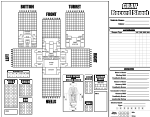 Centurion GIF Centurion TIF files (.zip) Centurion Damage Process |
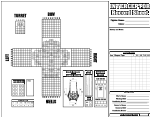 Interceptor GIF Interceptor TIF files (.zip) Interceptor Damage Process |
| Variant Number of Weapons, Weapon Placement, etc | BACK |
A Grav tank may carry a certain amount of weaponry based on it's size and class:
So a medium grav tank could carry four weapons and an AP laser on each of it's hull locations, and 4 weapons plus a Vulcan (or AP laser) in it's turret. (It would appear that Grav classifications are the same as for fighters: Light = 0-1500 rated engines, Med = 1501-2000, Hvy = 2001-2500)
What weapons, and how many, a crewmember can fire depends on their role:
Drivers are normally far to busy to fire any weapons. However, it is possible, but at a price. For each weapon a driver fires, the safe velocity of the terrain the tank occupies/travels through next turn is reduced by a third. Furthermore, all weapons fire by the driver is at a -2 penalty to hit and the driver must make an immediate piloting roll.
The gunner handles all direct-fire weaponry, and can handle any of the missile systems as well. No more than 8 (total) weapon systems can be fired by the gunner in a single turn.
The commander fires the targeting laser (very important) and can handle the missile systems (either at the primary or secondary target) and the AP lasers. They also set the rate of interceptions for the Vulcan system. If the gunner dies, then the commander may elect to take control of all the weapon systems, and can fire 8 systems total, including the painting laser.
| Variant Firing Arcs | BACK |
Weapons have firing arcs based on the type of weapon system and its placement:
Direct fire weapons placed in one of the hull locations have a firing arc same as in Interceptor OR (below) close to 45 degreesTurret mounted weapons have approx a 60 degree firing arc based on the direction the turret itself was aimed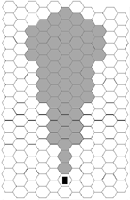 Missiles have a 120 degree arc of fire for hull mounted systems, or 120 degrees based on the facing of the turret for turret mounted systems
Missiles have a 120 degree arc of fire for hull mounted systems, or 120 degrees based on the facing of the turret for turret mounted systems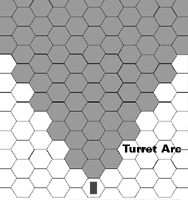
(This is the "standard" arc)AP lasers have a large arc of fire--turret mounted systems have a full 360 degree arc, while hull mounted AP lasers may fire at units in the forward 120 degree arc and along the left (or right) side
Lastly, Vulcan systems have no real facing, and can hit any incoming missile
Page design/contents by Kannik, 1997